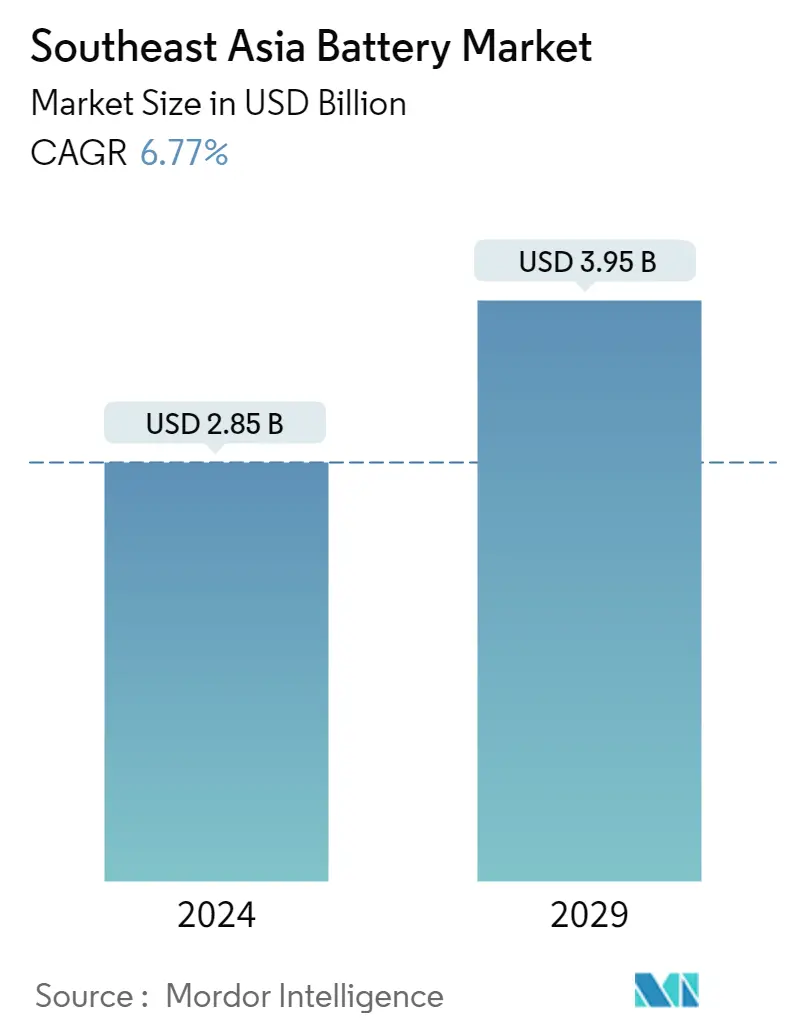Market Size of Southeast Asia Battery Industry

| Study Period | 2019 - 2029 |
| Base Year For Estimation | 2023 |
| Market Size (2024) | USD 2.85 Billion |
| Market Size (2029) | USD 3.95 Billion |
| CAGR (2024 - 2029) | 6.77 % |
| Market Concentration | Low |
Major Players/southeast-asia-battery-market---growth,-trends,-and-forecast-(2020---2025)_Companies_-_Southeast_Asia_Battery.webp)
*Disclaimer: Major Players sorted in no particular order |
Southeast Asia Battery Market Analysis
The Southeast Asia Battery Market size is estimated at USD 2.85 billion in 2024, and is expected to reach USD 3.95 billion by 2029, growing at a CAGR of 6.77% during the forecast period (2024-2029).
Though COVID-19 negatively impacted the market in 2020, it has reached pre-pandemic levels.
- Over the medium term, factors such as growing demand from the automotive sector, declining lithium-ion battery prices, and plans to make Southeast Asia a data center hub are expected to drive the market during the forecast period.
- Despite the growing demand for batteries in the automotive, data centers, and telecommunications sectors, the battery energy storage segment is expected to witness stagnant growth, as most countries depend on other energy storage alternatives. This, in turn, is likely to restrain the growth of the battery market in the energy storage segment during the forecast period.
- Moreover, plans to integrate renewable energy with the national grids in respective countries are expected to create significant opportunities for lithium-ion battery manufacturers and suppliers during the forecast period.
- Thailand is expected to dominate the market during the forecast period due to the increasing demand from the automotive, data center, and other end-user sectors.
Southeast Asia Battery Industry Segmentation
A battery is an energy source that converts chemical energy into electrical energy, consisting of one or two electrochemical cells, using a redox reaction.
The Southeast Asian battery market is segmented by battery type, end user, and geography. By battery type, the market is segmented into lead-acid batteries, lithium-ion batteries, and other battery types. By end user, the market is segmented into automotive, data centers, telecommunications, energy storage, and other end users. The report also covers the market size and forecasts for the market across major countries in the region. For each segment, market sizing and forecasts have been done based on revenue (USD billion).
| By Battery Type | |
| Lead-acid Battery | |
| Lithium-ion Battery | |
| Other Battery Types |
| By End-User | |
| Automotive | |
| Data Centers | |
| Telecommunication | |
| Energy Storage | |
| Other End-Users |
| By Geography | |
| Indonesia | |
| Malaysia | |
| Philippines | |
| Singapore | |
| Thailand | |
| Vietnam | |
| Myanmar | |
| Rest of Southeast Asia |
Southeast Asia Battery Market Size Summary
The Southeast Asia battery market is poised for significant growth, driven by increasing demand from the automotive sector and the declining costs of lithium-ion batteries. The region is witnessing a shift towards electric vehicles (EVs), propelled by environmental concerns and technological advancements in battery systems. Lithium-ion batteries, known for their high energy density and fast recharge capabilities, are becoming the preferred choice for EVs, replacing traditional lead-acid batteries. This transition is supported by government initiatives aimed at reducing emissions and promoting the adoption of EVs, which is expected to enhance the market's expansion. Despite the growth in automotive and data center sectors, the energy storage segment is anticipated to experience stagnant growth due to reliance on alternative energy storage solutions.
Thailand is expected to lead the Southeast Asian battery market, benefiting from its robust automotive production base and growing demand in the data center and telecommunications sectors. The country is evolving into a significant automotive manufacturing and export hub, with plans to increase its electric vehicle production under the National Electric Vehicle Policy Committee's roadmap. Additionally, Thailand's advancements in information and communication technology (ICT) and its strategic initiatives under the Thailand 4.0 Program are expected to drive demand for data centers, further boosting battery market growth. The market is characterized by partial fragmentation, with key players like Tianjin Lishen Battery Joint-Stock Co. Ltd., FIAMM Energy Technology SpA, and BYD Co. Ltd. actively participating in the region's development.
Southeast Asia Battery Market Size - Table of Contents
-
1. MARKET OVERVIEW
-
1.1 Introduction
-
1.2 Market Size and Demand Forecast in USD billion, till 2028
-
1.3 Recent Trends and Developments
-
1.4 Government Policies and Regulations
-
1.5 Market Dynamics
-
1.5.1 Drivers
-
1.5.2 Restraints
-
-
1.6 Supply Chain Analysis
-
1.7 Porter's Five Forces Analysis
-
1.7.1 Bargaining Power of Suppliers
-
1.7.2 Bargaining Power of Consumers
-
1.7.3 Threat of New Entrants
-
1.7.4 Threat of Substitute Products and Services
-
1.7.5 Intensity of Competitive Rivalry
-
-
-
2. MARKET SEGMENTATION
-
2.1 By Battery Type
-
2.1.1 Lead-acid Battery
-
2.1.2 Lithium-ion Battery
-
2.1.3 Other Battery Types
-
-
2.2 By End-User
-
2.2.1 Automotive
-
2.2.2 Data Centers
-
2.2.3 Telecommunication
-
2.2.4 Energy Storage
-
2.2.5 Other End-Users
-
-
2.3 By Geography
-
2.3.1 Indonesia
-
2.3.2 Malaysia
-
2.3.3 Philippines
-
2.3.4 Singapore
-
2.3.5 Thailand
-
2.3.6 Vietnam
-
2.3.7 Myanmar
-
2.3.8 Rest of Southeast Asia
-
-
Southeast Asia Battery Market Size FAQs
How big is the Southeast Asia Battery Market?
The Southeast Asia Battery Market size is expected to reach USD 2.85 billion in 2024 and grow at a CAGR of 6.77% to reach USD 3.95 billion by 2029.
What is the current Southeast Asia Battery Market size?
In 2024, the Southeast Asia Battery Market size is expected to reach USD 2.85 billion.

